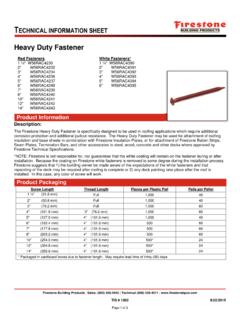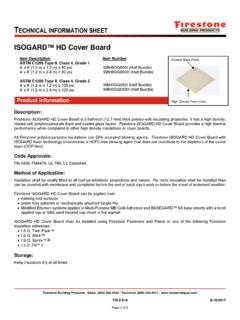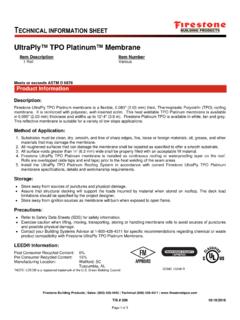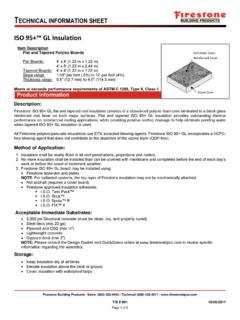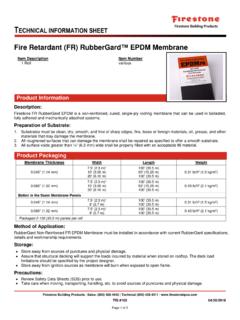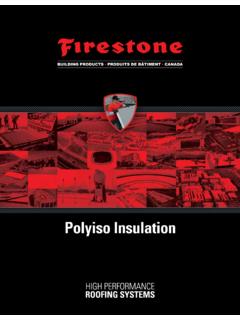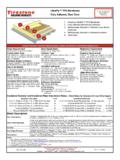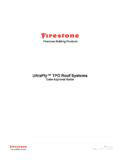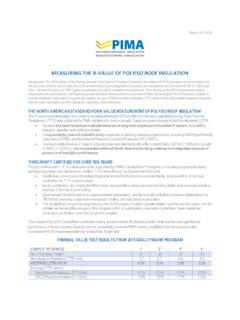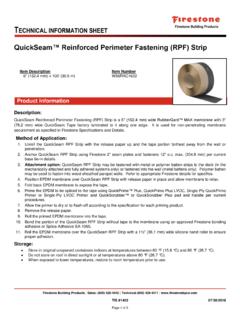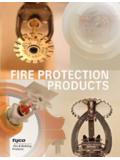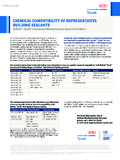Transcription of FIRESTONE BUILDING PRODUCTS
1 FIRESTONE BUILDING PRODUCTS . ROOF INSPECTION, MAINTENANCE & REPAIR GUIDE. CONTENTS: Section: Topic: Page: I. ROOF INSPECTION & MAINTENANCE 2. II. ROOF REPAIR & RENOVATION 14. III. FIRESTONE ROOF MAINTENANCE SERVICE 25. FIRESTONE BUILDING PRODUCTS COMPANY. Roof Inspection, Maintenance & Repair Guide Interim Updates at Revision No. 2 06/09/10. 1. SECTION I. ROOF INSPECTION & MAINTENANCE. All roofs require periodic inspection and maintenance in order to perform as designed and to provide a long and effective service life. Periodic inspection and maintenance is also typically required by roofing system manufacturers to keep roofing warranties in full force and effect. Although all BUILDING owners should establish a periodic roof inspection program, inspection and maintenance of any roof should be undertaken only by qualified persons who are familiar with safe roofing practices, including all applicable occupational, health and safety regulations relating to the roofing and construction industries.
2 Modern roofing systems contain a wide variety of components and installation techniques. All roof inspections should be conducted by a licensed roofing contractor or similar roofing professional. Typically, two inspections should be conducted each year, one in the spring and one in the late fall. If the roof is warranted, at least one roof inspection each year should be conducted by the licensed contractor who originally installed the roof. Please note that the cost of periodic inspection is typically not included in the original cost of a manufacturer's warranty. Accordingly, the BUILDING owner should contact a licensed contractor to obtain a proposal for ongoing inspection and maintenance services.
3 For additional information, including the most current details and specifications, please refer to the FIRESTONE Technical Database at FIRESTONE BUILDING PRODUCTS COMPANY. Roof Inspection, Maintenance & Repair Guide Interim Updates at Revision No. 2 06/09/10. 2. INDEX TO INSPECTION AND MAINTENANCE GUIDELINES: Section: Subject: Page: A. Roof Traffic 3. B. Contaminants 5. C. Drainage 6. D. Wind Storm Damage 7. E. Moisture Infiltration 9. F. Roof Membrane Seams 10. G. Base Attachments 11. H. Roof Inspection Checklist 13. A. Inspecting For ..ROOF TRAFFIC. INTRODUCTION: The FIRESTONE Roofing System is designed to be a waterproofing component not a traffic bearing component of the BUILDING envelope.
4 However, almost all roofing systems are subjected to some amount of foot traffic. Typically, roof traffic is necessary to service roof-top equipment. Occasionally, roofs may also be subjected to unauthorized foot traffic. Because roof traffic can damage the roofing system, periodic inspection is very important to assure that any damage is identified and addressed quickly. WHERE TO LOOK: 1. Roof Access Points. The roof surface area immediately adjacent to a point of access, such as a ladder, hatch or door typically receives more foot traffic than any other area of the roof. 2. Walkways and "Natural" Pathways. Even if a walkway system is provided, always look for the "natural" pathway, or the most direct route between access points and areas of frequent maintenance.
5 If roof walkways are installed in a square or right angle configuration, look for diagonal "short cuts" between adjoining walkways. 3. Rooftop Mechanical Equipment. Look around any equipment that requires periodic service. 4. Litter. The presence of bottles, cans or other litter is usually an indication of roof traffic and use. FIRESTONE BUILDING PRODUCTS COMPANY. Roof Inspection, Maintenance & Repair Guide Interim Updates at Revision No. 2 06/09/10. 3. WHAT TO LOOK FOR: 1. Cuts & Punctures. Small cuts in a roofing membrane are difficult to detect if the membrane is covered with a layer of dust or dirt. If cuts and punctures are suspected, the membrane should be cleaned with water and inspected.
6 Cuts and punctures may produce small bubbles in a film of water as pressure is applied to the surface of the membrane. 2. Compressed or Crushed Roof Insulation. Most roof insulations have relatively low compressive strengths and can easily be compressed or crushed if traffic loads exceed the strength of the insulation. Crushed insulation can be indicated by the presence of ponding water and "tented" insulation fasteners which did not compress along with the insulation. REMEDIAL ACTIONS: 1. Emergency Repair of Small Cuts & Punctures. Most single-ply cuts and punctures can be repaired temporarily by covering the cut or puncture with duct tape, construction grade butyl caulk, or silicone. Clean the membrane around the cut with a non-abrasive cleaner and apply a piece of duct tape extending beyond the cut or puncture at least one inch in all directions.
7 Most cuts and punctures in asphalt membranes can be repaired temporarily by applying plastic roof cement to the affected area. Make arrangements for a permanent repair as soon as possible. 2. Permanent Repair of Cuts & Punctures. Permanent repair of cuts and punctures should be performed by a licensed roofing contractor. ( See Section II. ). 3. Compressed or Crushed Roof Insulation. Insulation which has been crushed should be replaced with new insulation. Because this procedure will also require extensive repairs to the roofing membrane, this work should be performed by a licensed roofing contractor. PREVENTATIVE ACTIONS: 1. Roof Walkways. If roof traffic is extensive, the installation of a new or an enhanced roof walkway system should be considered.
8 ( See Section II for roof walkway specifications and guidelines. ). 2. Roof Access Log. In order to control and monitor roof access, procedures should be established to record the personnel, purpose, time and duration of all rooftop visits. FIRESTONE BUILDING PRODUCTS COMPANY. Roof Inspection, Maintenance & Repair Guide Interim Updates at Revision No. 2 06/09/10. 4. B. Inspecting For ..CONTAMINANTS. INTRODUCTION: Although most roof membranes provide outstanding resistance to natural weathering, their durability can be adversely affected by contact with many organic substances, including oils, fats, and organic solvents. Because exposure to these types of contaminants will cause many roofing membranes to lose strength and resiliency, periodic inspection is very important to assure that any damage is identified and addressed quickly.
9 WHERE TO LOOK: 1. Air Conditioner Compressors. Frequently, air conditioning units will leak oil, or oil may be spilled during periodic maintenance. 2. Kitchen Exhaust Fans. Grease from cooking exhausts can accumulate, especially if filters are not cleaned frequently. WHAT TO LOOK FOR: 1. Membrane Swelling. Some single-ply membranes, such as EPDM or TPO, will exhibit swelling or buckling of the membrane. This is an indication that the membrane has absorbed the contaminant and that fundamental physical properties of the membrane have been compromised. 2. Membrane Splitting & Cracking. Contact with oils or organic solvents can embrittle asphalt roofs and some single-ply membranes by accelerating the loss of lighter weight components.
10 REMEDIAL ACTIONS: 1. Membrane Swelling, Splitting or Cracking. Membrane which has swelled or cracked should be replaced by a licensed contractor. PREVENTATIVE ACTIONS: 1. Redundant Membrane Layer. If contamination, especially from cooking exhausts, is considered to be chronic, a redundant layer of roofing membrane should be applied around the exhaust vent and the roof surface area typically affected by grease deposits. This additional layer should be installed by a licensed roofing contractor. 2. Grease Traps. A number of proprietary grease traps are available which can be placed around exhaust units to absorb fats and grease. Typically, these units will require periodic maintenance to function properly.
